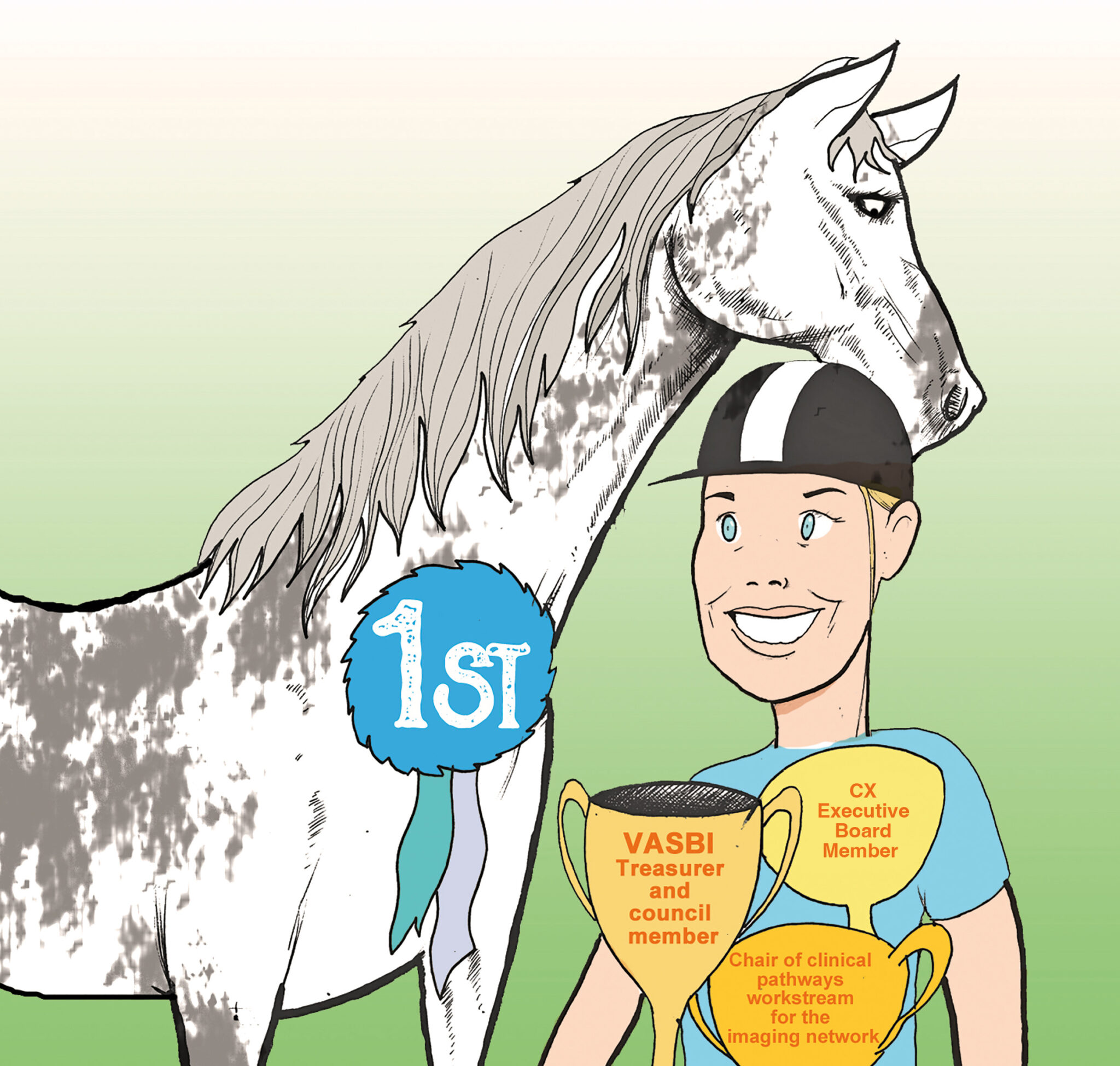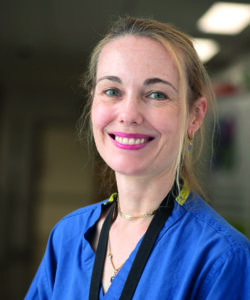 From choosing her specialty to competing in dressage, interventional radiology (IR) lead at East and North Herts NHS Trust (Stevenage, UK) Kate Steiner speaks to Renal Interventions on her career in IR, her inspirations in and outside of the field, and how she spends the moments between cases. Vascular Access Society of Great Britain and Ireland (VASBI) treasurer and Vascular Access Executive Board members of the Charing Cross (CX) Symposium, she offers her perspectives on drug-coated balloons (DCBs), IR provision, and more.
From choosing her specialty to competing in dressage, interventional radiology (IR) lead at East and North Herts NHS Trust (Stevenage, UK) Kate Steiner speaks to Renal Interventions on her career in IR, her inspirations in and outside of the field, and how she spends the moments between cases. Vascular Access Society of Great Britain and Ireland (VASBI) treasurer and Vascular Access Executive Board members of the Charing Cross (CX) Symposium, she offers her perspectives on drug-coated balloons (DCBs), IR provision, and more.
What drew you to a career in medicine and in interventional radiology (IR)?
During my junior doctor training, I spent time as a neurology senior house officer (SHO) and then as a senior clinical fellow in intensive care at the Royal Free Hospital (London, UK), which is where I also trained as a medical student. Prior to my intensive care job, I had completed my Membership of the Royal College of Physicians (MRCP) and was spending this time working out what speciality would suit. Initially, I had wanted to pursue a career in neurology. I had always had an interest in neuroscience and I had completed an intercalated BSc in psychology as part of my medical degree. However, throughout my training I had always been very good at and enjoyed procedures such as central line insertion, arterial line insertion, and lumbar puncture—and I could cannulate the proverbial stone. While reading What Colour Is Your Parachute?, trying to work out what my next step in medicine would be, I went into an interventional radiologist’s office to ask advice on a difficult patient, and we got chatting about my career. He reminded me how much I had enjoyed the weekly neuroradiology teaching, and that I had an aptitude for interpreting imaging. He asked if I had considered a career in radiology. Radiology and IR were not something I had had any exposure to. I then spent some time in the radiology department and have never looked back! When I was in my second year of radiology training, I was taken aside by one of the interventional radiology fellows who had spotted I had an ability for IR, and she encouraged me to pursue it as a career. IR offers patients a minimally invasive treatment option that usually only required conscious sedation and can treat life threatening conditions such as acute haemorrhage. As a trainee, you see the high levels of patient satisfaction and how a couple of inexpensive coils and a sheath can save a life. It was clear to me that IR was a rewarding and exciting speciality to be part of, where advances in technology were leading to improvements in patient care.
Do you have a mentor who has helped and inspired you in your career?
I have a mentor: she is an expert on women’s economic empowerment, with a special interest in women in global supply chains, and has a Membership of the Order of the British Empire (MBE). Having a mentor whose work is outside of medicine has provided me with a fresh perspective on many tricky issues and some useful tools to help me address them. Later in my career, I have unfortunately encountered people whose worldview has somewhat stereotypical opinions of women. Having a mentor has encouraged and enabled me to look past these attitudes and behaviours, and to continue to “lean in” and pursue my career goals.
Is there a particular case that has stayed with you during your career?
There is not a particular case that has stayed with me during my career, but there are many patients. The patients that we treat for arteriovenous (AV) access dysfunction and dialysis access often come back for repeat diagnostic ultrasound and for repeat endovascular procedures. Over time, you get to know each other well and a doctor-patient relationship develops. This makes AV access one of the most rewarding specialities to be part of.
Are there any recent developments in IR and kidney care that most excite you?
I think that endovascular arteriovenous fistulas (endoAVFs) have been the most innovative advance in dialysis access for many years. The other development which I believe will have a major positive impact on patient care is the publication of the Kidney Disease Outcomes Quality Initiative (KDOQI) 2019 guidelines. The individualised End Stage Kidney Disease Lifeplan (ESDL), focusing on “right access, at the right time, for the right patient, for the right reasons”, is a patient-centred approach. This should lead to improvements in quality of care.
How do you think access to IR care can be improved for kidney patients in the UK?
The first step to improving access to IR care in the UK is taking a patient-centred, multidisciplinary approach. Where multidisciplinary teams which include interventional radiologists work together, this results in better quality care where patients will be offered a wider choice of treatment options. New emerging technology tends to be adopted in larger centres with interested interventional radiologists, while smaller centres may not have the time, resources or managerial support available to do this. Centralisation of lower volume procedures may mean that patients at smaller units can access speciality services at larger centres. At present, patients are not always referred onwards.

What is your perspective on the existing endoAVF options?
The safety and efficacy of the current devices has been demonstrated in the published trial data. The existing endoAVF devices in my opinion offer additional access options for patients which confers certain advantages, especially to younger patients or those patients who benefit from not having a high-flow upper arm AVF. At my institution, we have an endoAVF programme using the Ellipsys (Medtronic) device. Patients are very well-informed about their options, and even before starting the programme we had patients asking for an endoAVF. Patients sometimes prefer the cosmetic appearance of the endoAVF compared with a surgical fistula. They also hear from other patients that they have had a good experience with their endoAVF, which can often be cannulated early at around the four week mark. We have some patients who have refused a surgical fistula (sAVF), accepted an endoAVF, and are now dialysing via a functional AVF, and their catheter has been removed.
What is your current appraisal of drug-coated balloons (DCBs) and where they are appropriate?
In the IN.PACT AV access study, we now have a high-quality prospective, multicentre, randomised controlled trial (RCT) demonstrating the benefit of DBCs in AV access. However, the evidence from other trials and publications is mixed. I use DCBs in my practice, and have seen the benefit of less frequent repeat interventions for patients. However, I do not believe it is cost effective and best practice to use them for every lesion in every patient. Some patients will go a long time between interventions with effective plain-balloon angioplasty. Predicting who will respond well to plain-balloon angioplasty and who will benefit from DCB use is difficult. In my practice, I will almost certainly use a DCB for a recurrent lesion where there is intimal hyperplasia seen on ultrasound. I believe that in the future we will adopt a more patient-centred approach, with algorithms for treatment based on lesion appearance on b-mode ultrasound, lesion location, previous interventions, and perhaps biochemical/lesion markers which we do not yet fully understand.
How do you feel your work with VASBI fits into the landscape of vascular access?
I think it is an exciting time for VASBI. I hope that our work as a council will help lead to better quality care for dialysis patients. The VASBI meeting showcases new technologies and advances in dialysis care. One of the aspects of the VASBI meeting which I have always found particularly useful in shaping my own practice is the examples of good clinical practice using existing technology and resources available to most centres which are shared both on and off the podium. VASBI is a truly multidisciplinary council and meeting, which I think allows us all to learn from and disseminate knowledge across co-dependent specialities in AV access. Research is now playing a more central role in the council agenda, and research specifically aimed at addressing key issues in dialysis access is essential to obtain the evidence needed to guide best practice.
What is your philosophy within medicine?
My philosophy within medicine is to take a patient-centred approach. I believe that improvements in patient pathways and protocols, as well as resulting in better quality, safer care for patients, also leads to improvements in staff satisfaction and working conditions. We have seen this clearly with the build of our interventional radiology day case unit. One of my pet peeves is where silo working leads to conflicts between clinical specialities, either at a clinical, managerial or financial level, and “turf wars”—usually centred on limited financial resources or self-interest—lead to poor-quality patient care. My work as the chair of the clinical pathways workstream with the East of England E2 Imaging Network is to establish agreed uniform patient pathways and protocols across the network to improve patient experience and care. One of the most rewarding aspects of this role is learning from centres where there is good practice, and seeing this practice gradually adopted across other trusts within the network.
What are your interests outside of medicine?
I love to spend my free time with my husband, my son and family. I am a keen equestrian—I have a beautiful Lusitano mare, we have fun together and compete in dressage. When I am not at work or at home I will be at the stables!
Fact file
Current appointments:
- Consultant interventional radiologist and interventional radiology clinical lead: Lister Hospital East and North Herts NHS Trust and Hertfordshire and West Essex Vascular Network (Stevenage, UK)
- Clinical Pathways Workstream Chair: East of England Imaging Network
Education:
- 2002: Membership of the Royal College of Physicians
- 2008: Fellowship of the Royal College of Radiologists
- 2010–12: Subspeciality fellowship in interventional radiology: Royal Free Hospital (London, UK)
Honours (selected):
- 1997: Glaxo-Wellcome Blackwell book prize for clinical skill and knowledge
- 1999: Bunzl prize in psychiatry
- 2000: Runner-Up in the Royal Free Art Society ART 2000 exhibition
- 2009: British Society of Interventional Radiology (BSIR) 2009 award for the best oral presentation by a trainee (BSIR 2009 Brighton)
- 2017–present day: Vascular Access Society of Britain and Ireland (VASBI) council member, 2022 elected treasurer
- 2023: Co-chair of the Charing Cross (CX) International Symposium: Vascular Access Masterclass with Nicholas Inston. Executive Board member for the Charing Cross Vascular Symposium











